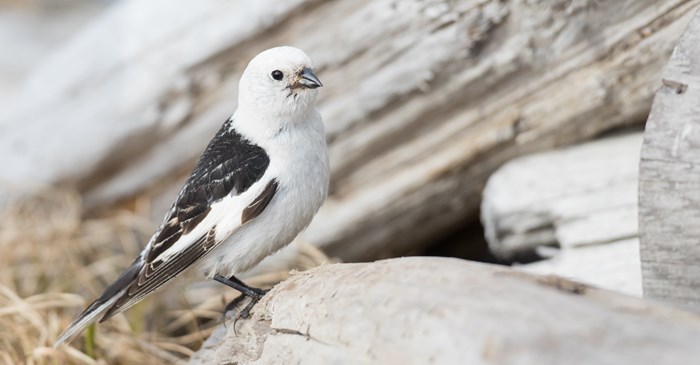There’s little about a Snow Bunting that isn’t perfectly suited to life in the deep freeze. These winter wanderers are outfitted like little polar explorers, with a natural down parka of dense white feathers that cover even the birds’ ankles and base of the bill—and keeps their exposure to cold at a minimum.
The adaptations are more than skin deep. A Snow Bunting’s body temperature can dip 30 to 40 percent lower than other songbirds their size before hypothermia sets in. As weather conditions deteriorate, Snow Buntings can adjust their metabolism to quickly turn food into insulating body fat. And when the cold air arrives, they bury themselves in snowdrifts for warmth.
All these feats add up to a species that breeds farther north than any other songbird, returning to its Arctic nesting territories in March and singing its heart out when temperatures can still drop well below zero. Snow Buntings are so hardy, in fact, that the only time most people get to see them is during winter, when flocks magically appear and disappear over snow-blown northern fields, seemingly undeterred by what we call winter.
For bird watchers, the little bird with a toasted marshmallow pattern is a bright spot in a gray winter. In eastern Canada, Snow Buntings have even inspired a citizen-science project. Started in 2006, the Canadian Snow Bunting Network has been collecting data on their occurrence during winter across almost all of the Canadian provinces. Now scientist Oliver Love is using the network’s extensive data set, along with his own findings from tracking individual birds, to open up a window on where these mysterious birds live their lives, and where they go when the weather gets bad.
The Snow Bunting’s biggest forays are its migrations between tundra breeding grounds and wintering areas among the farm fields of Canada and the northern U.S., when it flies across the largest expanse of forest on the continent. The boreal forest is home sweet home for billions of forest birds, but it may as well be an ocean for open-country species such as Snow Buntings. In fact, Love and his team have found through geolocator tracking that migrating Snow Buntings actually treat the boreal forest like an ocean, much like Ruby-throated Hummingbirds treat the Gulf of Mexico—as an enormous barrier to cross over. The buntings bypass the entire forest in nonstop flights of hundreds of miles.
